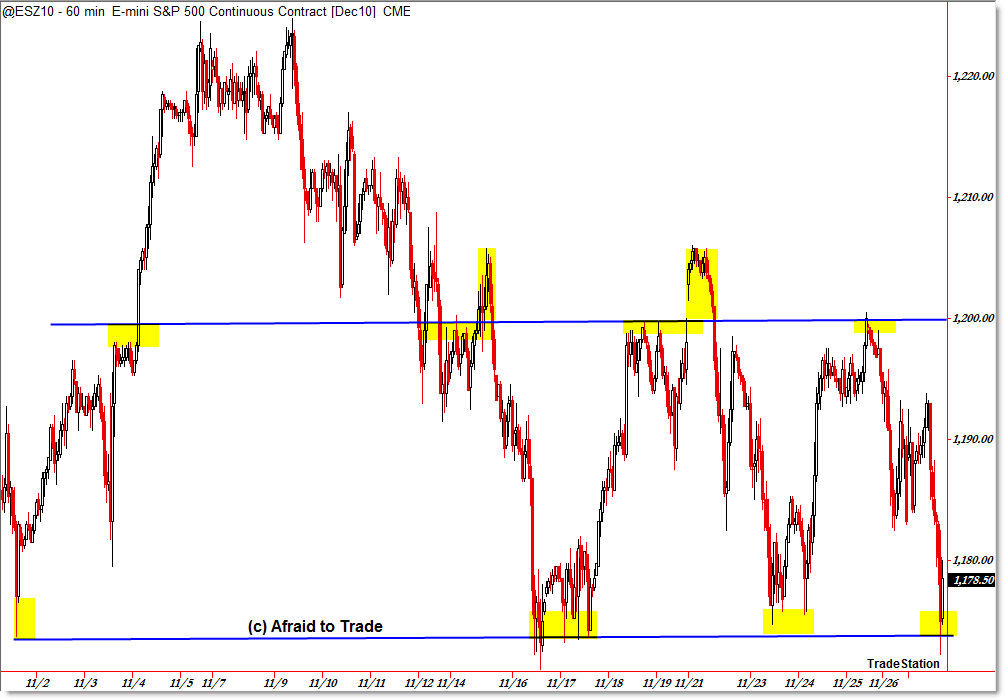Key Intraday Range Levels for ES Futures and SP500
I’ve been making note lately about the “range” between the 1,200 level in the S&P 500 as short-term resistance and 1,175 as the short-term support.
Let’s now step into the futures market – including overnight levels – to see the current structure of the compressed range and what it means for intraday traders right now.
First, the broader 60-min @ES Futures Structure:
(Click for full-size image)
The broader structure shows us the 1,200 level as important resistance, and the big Post-Fed (QE2) “Bull Trap” along with two mini-bull traps after price broke back under 1,200.
Traps are often labeled “Excess” and indicate a market that initially pushed above resistance but then one of two things failed to occur:
A) Buyers FAILED to step-in and buy the breakout (implying the higher price was deemed “expensive” at the time)
B) Short-sellers FAILED to step OUT and buy-back to cover short-positions at a loss.
Price breakouts are often fueled by both forces – buyers rushing in and sellers (short) rushing out.
So far, that has not happened – it could, but it’s not occurred so far. That’s important to know.
OTHERWISE
Buyers have created a floor of support at the 1,170/1,175 level, which happens to be the rising 50 day EMA and lower Bollinger Band (higher timeframe structure).
It’s now a reference level in its own right, having “rejected” price declines at least four times as shown above.
Buyers deem the 1,170 level “cheap” (short-term) and thus have stepped in to buy.
Let’s drop now to the 15-min overnight futures chart for a clearer glimpse:
(click for full-size image)
We see the 1,200 and 1,170/1,175 key levels again but from a tighter perspective.
The main idea is that there is a disadvantage at trying to trade for anything long-term while price remains trapped within these bounds, and a potential advantage – as long as these levels hold – for the short-term traders to play off these ranges.
They will certainly not hold forever, but traders – by their combined actions -have deemed these levels to be important in the short-term.
Markets alternate between Range Contraction (this) and Range Expansion (a breakout) – so we know a breakout is coming, but it’s often best to wait for confirmation of a break instead of trying to outsmart the market and guess the breakout direction until it occurs.
The short-term targets are relatively clear again from a short-term basis as I’ve been saying in the member reports:
A) Bullish Breakout (that exceeds the recent ‘traps’) targets a potential play to 1,230
B) Bearish Breakout (under 1,170) likely targets the 1,150 level again with a deeper break targeting 1,130.
Depending on your style of trading and experience, I would strongly suggest incorporating these levels into your game plan for expectations of the next likely move – whether it be within the parameters of this price range… or outside of them on a breakout move.
Corey Rosenbloom, CMT
Afraid to Trade.com
Follow Corey on Twitter: http://twitter.com/afraidtotrade



good stuff, well said.
Hi Corey,
You teach about popped stops… would you say they are in action today on silver and gold?
My apologies for the delay in responding – but no, not necessarily in SLV and GLD (in terms of yesterday's really big rally).
Popped Stops triggers and perpetuates when there is a known/easy-to-spot short-sale opportunity (such as a breakdown under support, or push up into resistance) that immediately FAILS and thus traders who just got short are forced to rush and cover short (buy).
In the context of SLV and GLD, both were above key daily support levels and didn't trigger an obvious short. It was perhaps more a case of buyers rushing in than sellers rushing out.
Now, if SLV and GLD break to new highs and a lot of traders remain stubbornly short, then yes, we can expect additional big surge moves up similar to those that took us to new highs recently.